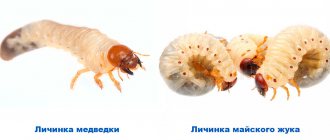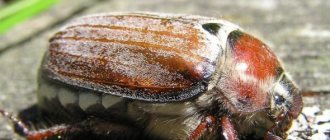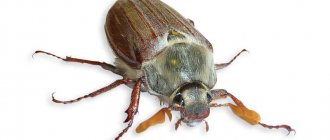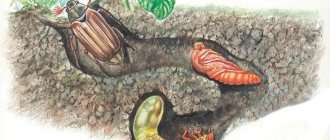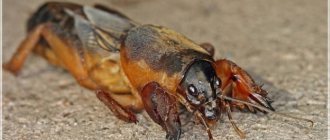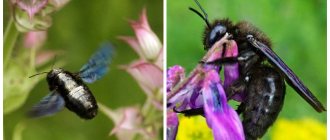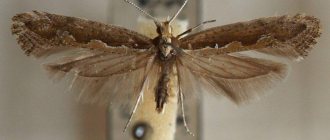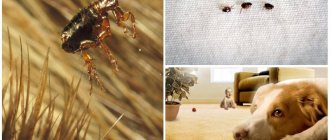With the onset of May warmth, the active flight of the cockchafer begins. Both the insect itself and, most importantly, its larvae destroy plants, eating leaves and gnawing roots. Is it possible to protect your garden and garden from pest invasion and how to do this effectively?
The cockchafer lives in Europe and Asia. Adults are quite large (the length of the oval body can reach 3.5 cm). The color of the beetle is black or red-brown; there may be a greenish tint on the head and back. There are small dotted lines, hairs or hair-like scales on the body. The tarsi are also covered with hairs, and the front tibiae have 2 or 3 teeth.
In the spring, insects leave their wintering grounds, and their flight lasts 1-1.5 months. At the beginning of June, females lay eggs in the soil (each - up to 70 eggs). In this case, beetles prefer mainly sandy and sandy loam soils, as well as compost heaps, since underground passages can be easily built in them.
Khrushchev larvae (also called furrow larvae) pose a great danger to gardens and vegetable gardens. They have a rather large and thick twisted body (up to 6 cm long) of white, beige, pale yellow or brown color, a rounded head and three pairs of legs. From the moment of hatching from the egg to pupation, the larvae develop over the course of 3-4 years and during this time they manage to cause serious damage to plants. At the end of summer - beginning of autumn, they turn into beetles, which remain overwintering in the soil.
This is what the cockchafer and its larva look like
Description of the cockchafer and its larvae
Chafer
Adults are large, reach 3.5–4 mm in length and are black or red-brown in color. The body is soft, barrel-shaped, covered with dense hairs. It is elongated and passes into a process at the back.
The body consists of 3 sections: head, chest and abdomen. On the head there is a mouth, a pair of compound eyes consisting of many simple ocelli. In front of the eyes there are antennae with expanded plates at the end. These are the insect’s olfactory organs; in males they are more developed.
The beetles have 3 pairs of legs on their chest, and on their back the wings are protected by hard, elongated elytra. Insects have sharp jaws; with the ends of the upper jaw they bite off pieces of leaves, and with the lower jaws they grind them.
In addition to the digestive organs, chafer beetles, like other arthropods, have developed circulatory, respiratory, excretory, nervous and reproductive systems. Externally, males differ from females in the size of their antennae; they are longer and curved.
The larvae do not look like adult beetles. They have a thick, soft and arched body of a whitish color, 3–5 cm long. A large head and three pairs of legs are distinguished by a yellow-brown color. The wings are not developed, but there are spiracles on the sides of the body.
From a larva, the pest turns into a pupa, which in appearance is already similar to an adult cockchafer. The pupa has a formed head with antennae, compound eyes and legs. The wings are shorter than those of an adult insect, the chitinous cover is dense and without a characteristic color. The pupa moves slightly, but cannot move or absorb food.
There are 6 species of cockchafer found in our country. The most common are the western and eastern types. They are similar to each other and differ only in the structure of the abdomen.
Preventive measures
A set of agrotechnical measures will protect the site from the invasion of beetles:
- Timely digging of the soil in the spring will help to detect furrow weeds in a timely manner - this is the most effective method of prevention.
- Mulching the area will prevent females from burrowing into the ground and laying eggs. You can use the following as mulch:
- dry tree bark;
- sawdust;
- egg shells;
- straw.
- High-quality weeding , which destroys weeds, will protect against the accumulation of not only beetle larvae, but also other harmful insects.
- Confinement - one of the most effective ways to protect an area from larvae. Legume plants accumulate nitrogen in nodules located on the roots. Planting legumes such as:
- white clover (creeping);
- lupine;
- sweet clover;
- beans;
- beans;
- peas
Creeping clover
will saturate the soil with nitrogen, which furrows cannot tolerate.
Life cycle of a pest
The insect goes through 4 stages of development: egg, larva, pupa, imago (adult). With the arrival of spring after the leaves bloom, the summer of the May beetles begins, coming out of hiding. It lasts 1–1.5 months. At this time, mating occurs and in June the females lay eggs in the soil to a depth of 10–20 cm. Oviposition can be found not only in the ground, but also in the hollows of old trees. Each female lays up to 70–80 pieces and then dies.
After 4–6 weeks, thick yellow-white larvae emerge from the eggs. This stage is the longest, it takes place underground for 3–4 years. The larvae have 4 stages of maturation, accompanied by summer molts. In the first year, when the oral organ is not formed, young larvae feed on humus and small roots; from the next year their appetites grow and the larvae switch to feeding on the roots of trees, vegetables, and shrubs.
In warm weather, the larvae rise to the soil surface into the root layer, and with the arrival of winter they go 50–70 cm deeper. As they grow older, they become more dangerous. The pest grows and needs more food.
The larvae turn into immobile pupae at the end of the cycle - at the end of summer or at the beginning of autumn. After 1.5 months, the chitinous cover of the pupa bursts and adult insects appear. They will remain deep underground until spring comes.
Adult beetles live 1 year. It has been noticed that after 25–30 years there is a sharp increase in the number of pests. This is preceded by 3–4 years of decreased insect activity.
Stages of development
The female cockchafer lays eggs after 2-3 weeks of the life cycle. After laying, she looks for a male again and the cycle repeats. During her life, the female Khrushchev lays eggs 3-4 times, then dies. The life of a Khrushchev is divided into 4 stages:
- Egg . The cockchafer lays white eggs 0.3 centimeters long and 0.2 centimeters wide. The egg development cycle lasts from 24 to 50 days.
- Larva . As the egg develops, it hardens and then a larva forms. They are thick and curved, light in color and 65 mm in length. She can stay in this stage for up to 4 years.
- Doll . The pupa is yellowish in color and lives in the ground. It is similar in appearance to an adult beetle, but has shorter wings. It is 0.25 centimeters long. The pupal stage lasts 2-4 weeks.
- Adult beetle.
Signs of plant infection
Adults feed mainly on leaves. They eat or make holes in leaf blades, damage buds, ovaries and flowers . Because of this, the process of photosynthesis in plants is disrupted, they weaken and wither.
The larvae cause more harm; they are voracious and damage plant roots ; 3–5 pieces can completely destroy the root system of a young tree . Even minor damage makes the plant vulnerable to pathogens. Young plants wither and are easily removed from the ground , and adult specimens, having a reserve of vitality, do not die, but slow down their development. Yields of vegetables and fruits are reduced, side shoots on trees do not ripen well.
Adult insects and larvae are easy to detect on above-ground parts and in the soil and make sure that they are the cause of crop damage.
How does Khrushchev harm the garden?
The main food of the adult cockchafer is birch, maple, aspen, oak, poplar and linden leaves.
The pest, having occupied the garden, eats the greens of cherries, sea buckthorn, apple trees, black currants, plums and even lilac bushes.
Khrushchev causes the greatest damage to trees once every 3–5 years. This is due to the full development cycle: for red beetles - 4 years, black - 5 years. In two months, these insatiable insects are capable of destroying all the foliage on trees.
Larvae are no less dangerous. Young individuals eat the roots of garden trees and shrubs, seedlings, vegetable crops - corn, any seedlings, potato tubers, seedlings, strawberries and even lawn grass. The gluttony is amazing: in one day, a three-year-old larva gnaws the rhizome of a two-year-old pine.
The presence of Khrushchev is easy to notice not only by its enormous size. The beetle eats leaves, buds, and sometimes ovaries. If the larva damages the roots, the plant is easily pulled out of the ground, withers, and develops poorly.
Reasons for the appearance of the pest on the site
May beetles prefer sandy soils ; they are less common in heavy clay areas. It is more convenient for females to lay eggs in uncompacted soil. They love well-groomed and cultivated gardens and vegetable gardens ; here they have favorable conditions - nutritious soil, many plants, compost and humus heaps .
The life activity of the larvae is affected by temperature and humidity. High humidity is detrimental to them, and when the temperature rises above 25°C, they sink to great depths. During spring cold snaps and recurrent frosts, the cockchafers freeze and may die.
Pest numbers are reduced by exposure to fungi, bacteria and parasitic nematodes.
Biological drugs
Boverin
Another insecticide "Boverin". It is a preparation based on the sporozoan mushroom Beauveria bassianl, which is poisonous to insects.
When it gets on the body of an insect, it begins to germinate and penetrate inside the beetle. Once the pest enters the body, it releases toxic substances that quickly kill it.
Nemabact
Biological product against pests in the soil. An undoubted advantage is that it is environmentally friendly and does not harm humans and their pets at all. Kills the beetle at the larval stage.
Used for watering in the morning and evening. After taking it, the larva dies within 1-3 days. There are restrictions on temperature, can only be used at 10-26 degrees and high humidity.
What crops does the pest affect?
Chafer beetles are polyphagous and damage many crops. Adult insects gnaw leaves and ovaries of poplar, oak, maple, birch, aspen, alder, walnut, linden, willow, elderberry, acacia, elm, honeysuckle, alder, rowan, and rosehip .
The insect can be seen on fruit trees and shrubs: apple, plum, cherry, grapes, sea buckthorn, black currant, gooseberry . Beetles love the needles of pine, spruce, larch, and cedar . Only the ash tree is lucky; the pest avoids it.
The larvae feed on the roots of these trees, roots and root crops of vegetable crops: potatoes, onions, beets, corn, sunflowers . The larvae cause great damage to strawberry .
What harm does the insect cause?
The main food of the cockchafer is young shoots and leaves of the plant. The beetle is capable of leaving a tree with only bare branches in a couple of months.
The beetle itself is not so dangerous for cultivated plants; its larvae are most dangerous They are practically invisible to the eye because they are underground.
At the same time, they destroy the root system of the plant, and it completely dies.
Most often, trees such as cherry, apple, plum or sea buckthorn are targets for beetle attack The beetle also settles on currants and lilacs, birch and aspen. The larvae are not so selective in food and are capable of destroying any plants that are in the summer cottage.
What remedies exist against cockchafer larvae?
How to get rid of cockchafer larvae
Chemical and biological drugs
Antikhrushch
The insectoacaricide affects the nervous system of the pest, paralyzes it and the larvae quickly die. Indirectly, the drug reduces the risk of viral and fungal diseases.
Before planting potatoes, the soil is sprayed with a working solution at the rate of 10 ml of product per 5–10 liters of water. This volume is designed to process 1 hundred square meters.
To soak the roots of vegetable seedlings and fruit tree seedlings, dilute 10 ml in 3 liters of water.
The soil around strawberries, berry bushes and fruit trees is watered with a solution of 10 ml of the drug and 5 liters of water.
Vallar
According to reviews from summer residents, this new drug is one of the most reliable in the fight against May beetle larvae. 5–6 granules are scattered around the plants in the root zone and embedded in the soil to a depth of 5–10 cm.
Before planting, a mixture of an insecticide solution with soil is prepared to treat the roots of seedlings of fruit and ornamental plants. 3 tsp of the product is added to 200 ml of water and stirred. Pour soil into the container, add the solution and pour in more water, bringing the volume of the “chatterbox” to 1 liter. The roots are dipped into this mass before planting.
Zemlin
Once in the pest's body, the insecticide blocks basic life functions. The larvae cannot move, absorb food and soon die. Granules of the drug are applied to the ground when planting plants in holes or during the growing season at the rate of 30 g per 20 square meters. m.
Bazudin
Contact insecticide with intestinal action based on diazinon. The consumption rate of the drug is 30 g of granules per 20 square meters. m. landing. They are first mixed with dry sand or sawdust, the soil is loosened and the mixture is scattered evenly.
Initiative
An effective contact action drug. Shows protective properties during the first day after use. 30 g of microgranules are poured into a 1 liter container of dry sand, mixed and evenly scattered around the root zone.
Nemabact
A unique biological product for pest larvae based on beneficial nematodes. The contents of the package (foam rubber crumbs) are poured into a colander, which is placed on a bucket and washed with water (10 l), periodically squeezing out the crumbs. The resulting solution is stirred and used to water the soil.
Traditional methods
- Plants are watered at the root with a strong infusion of onion peels. Half the bucket is filled with onion peels, hot water is added to the brim and left for a day. The infusion is filtered, but not diluted before use.
- Ammonia will repel larvae from the area. Dissolve 20–30 ml in 10 liters of water and water the soil. This treatment is also good as a preventive measure for strawberry bushes.
- To prevent the pest, potato seedlings and vegetable seedlings are watered with a solution of potassium permanganate (3–5 g per 10 liters of water). The soil has been watered with the indicated solutions since May, when the pest has already risen to the root layer.
- Mustard clears the area of larvae; they do not like the smell of this plant. Starting in spring, the row spacing and soil around the trees are sown with mustard or other cruciferous crops. When the green mass grows, it is embedded in the soil.
- Planting leguminous plants has a similar effect on the pest: lupine, beans, peas, beans. The soil under trees and shrubs can be covered with white clover. On the roots of this plant, as well as on legumes, bacteria are formed that participate in the accumulation of nitrogen in the soil. The cockchafer larvae cannot tolerate this.
- In May, adults are collected by hand. In the morning, insects are inactive, so when they are spotted, the branches of trees and shrubs are carefully shaken off, the beetles are collected and destroyed.
- Traps are built to catch insects. Plastic bottles with cut off necks are hung on trees. Sweet fermented liquid (compote, diluted jam, kvass, beer) is poured into containers.
- The cockchafer is attracted to any light source at night. Therefore, the trap is installed next to a switched-on flashlight or light bulb. The bait can be a wide container of water: a basin, a bucket, a bowl.
- For another option, the inner walls of an empty container are coated with any viscous and sticky substance. The insects that fly to the light will fall into a trap; in the morning all that remains is to collect and destroy them.
Prevention of appearance: tips and recommendations
It is impossible to completely protect your garden, but everyone can reduce the risk of voracious pests. To do this, it is necessary to use an integrated approach: fight with mechanical or chemical methods, use folk remedies. For prevention purposes, it is necessary to regularly dig up the soil and treat it with disinfectant solutions. A big plus is that such methods allow you to simultaneously get rid of other garden “aliens” and reduce the risk of fruit damage by pests.
What you should take into account:
- In the spring, when beetles are active, it is necessary to regularly collect beetles from trees, use light traps, and attract natural enemies.
- Plants with a strong odor (onions, garlic, marigolds, clover) can be used as a deterrent. Rows with these crops are placed between plantings. May beetles also do not like members of the cruciferous family (cabbage, radishes, radishes).
- In case of severe infestations, it is more advisable to choose a chemical or bacteriological insecticide and use green manure plants.
The appearance of a cockchafer on strawberries is an alarming sign for any gardener. Voracious pests are capable of destroying plantings, so various methods are used to destroy these insects. An overview of the best ways to deal with them is given in our information.
Prevention
- The simplest agrotechnical method against the pest is spring digging of the soil in the beds and in the tree trunks. At this time, the larvae are easy to spot. Tillage is mandatory for virgin areas. On such lands there is always a large concentration of the pest.
- The garden and garden are kept clean throughout the season and weeds, especially wheatgrass, are destroyed in a timely manner. It attracts not only wireworms, but also cockchafer larvae.
- Mulching the soil is useful. A loose layer of crushed straw and wood shavings prevents females from laying eggs.
- The pest has many natural enemies, including various birds, hedgehogs, ground beetles, and moles. To attract birds, you can install several birdhouses on the site. They will save plants from damage by both adult beetles and larvae.
If you do not hesitate and use the whole range of measures, then all attacks of the cockchafer and larvae can be successfully repelled and make your area unattractive to the pest.
You will learn more about how to deal with cockchafer larvae from the video.
Ways to combat Khrushchev
The methods developed to combat the cockchafer are varied. Conventionally, they can be divided into mechanical, biological and chemical, depending on the means used.
Catching chafers
The easiest way to destroy the cockchafer on strawberries is to collect adult individuals and regularly dig up the soil. This way you can prevent further contamination of the soil, but it is necessary to act systematically, involving the owners of adjacent plots in the fight.
Homemade traps
The mechanical collection of specimens can be improved and facilitated by using homemade traps. To do this, it is necessary to provide an environment that is attractive from the point of view of insects, for example, a compost pit. Containers with “bait” are regularly inspected, and any found specimens are destroyed.
Trap
You can make glue baits yourself, and also scatter potato tubers treated with insecticide around the garden. Light traps work well, but it is impossible to completely get rid of pests using such methods.
Appearance
When the first greenery appears on the trees, various garden pests also appear. It is during this period, having safely overwintered in the ground, that the female May beetle or beetle begins to lay eggs. She lays them very deep - almost a meter deep, which makes it impossible to detect the masonry. Immediately after this, the females die, and after 20 days, larvae begin to hatch from a large number of eggs (on average 100 pieces). At a young age they are almost harmless, but as they mature they become formidable pests for garden and vegetable crops.
On a note!
Externally, the cockchafer larva looks like a thick white-yellow caterpillar with spots and rings on its sides. They are no larger in size than small worms, but already in the 2nd year they are 5 cm long, and then grow to 6.5-7 cm.
Their characteristic feature is a ring-shaped C-shape, but as they develop they increase in size, and a brown head becomes noticeable, on which there are no eyes (they are not needed underground). They have 3 pairs of legs covered with hair and a gnawing mouth with brown jaws, as seen in the photo of the cockchafer larva.
The main diet of beetle larvae consists of roots of garden crops. Through the thin skin of the abdomen you can see where food is digested. As the larva increases in size, it becomes more voracious and is able to eat larger plant roots.
On a note!
Underground they are able to move sometimes up to 100 m in length. As they develop, the larvae begin to crawl upward and try to get to the surface of the earth.
May beetle larvae
